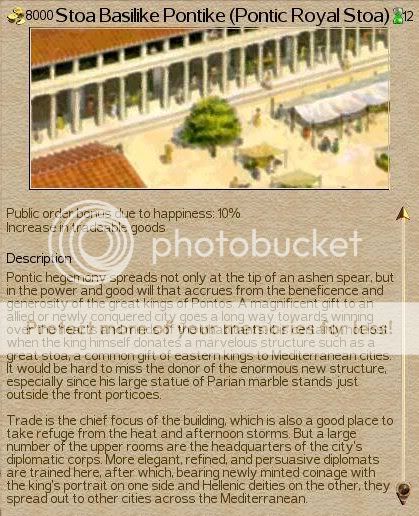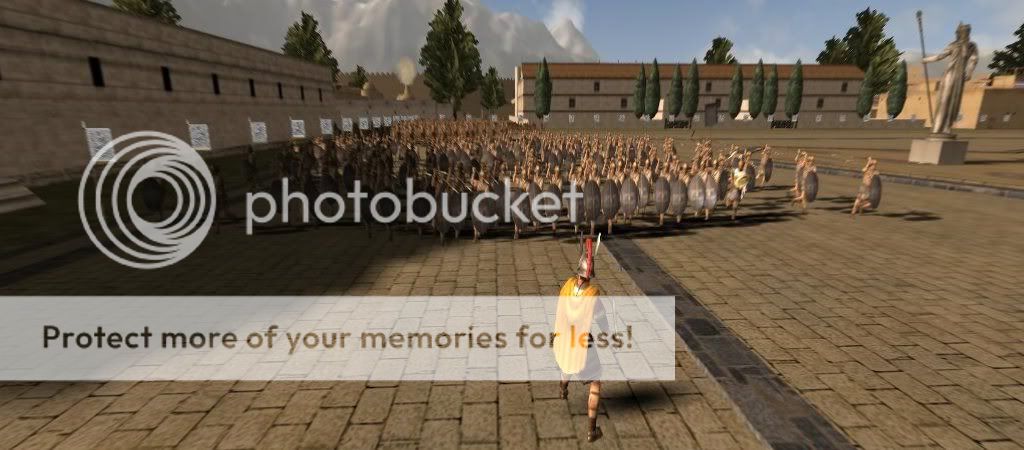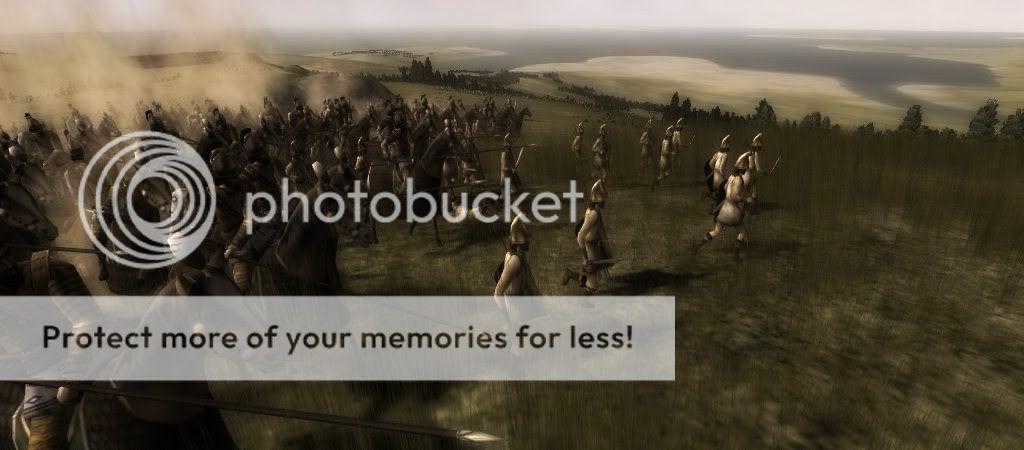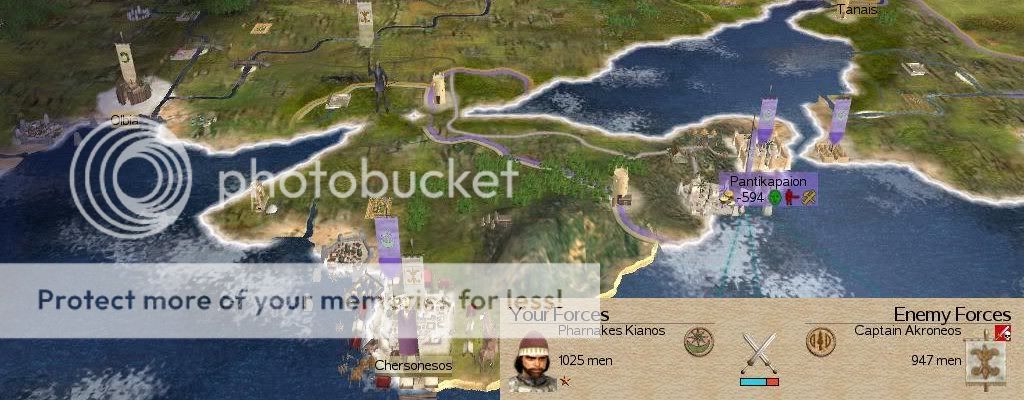Meanwhile the Pontic economy was booming. Brigands and rebels who had taken advantage of the general unrest to lay ambushes for unwary travellers were wiped out, and at sea a new Pontic navy, equipped with warships from the great harbor of Alexandreia, hunted down and sank the many pirates. The most well-established Pontic towns now had almost everything a man could ask for - and everywhere there were reminders of the source of this great fortune.

With riches always comes jealousy, and of all the lands surrounding Pontos, that of Makedonia proved the most jealous. Makedonia was embroiled in an endless war with Epeiros and the Koinon Hellenon, and although her colonies in western Asia Minor regularly sent manpower to fight in these wars, they couldn't seem to resist also sending small armies to "explore" in nearby Pontic lands. Hystaspis Kianos ordered the local garrisons to be greatly increased, and this show of power deterred the Makedonians from any attack - and thus Pontos and Makedonia remained officially "neutral". The insult, however, would not be easily forgotten.
By 213 BC, Hystaspis Kianos was growing old and grey, but he now had two sons of age. The first-born was Zenon Kianos, the smarter and more likable of the two, but also more full of himself. His younger brother Pharnakes had less natural talent, but made up for it with incessant energy - much like his father.
The other two male members of the Kianos clan with a claim to the throne were more distantly related, and were closer in age to Hystaspis Kianos than to his sons. Arses Kianos had conquered the Nile, and despite his age was still a capable general with an intense loyalty to Hystaspis. At the other end of the family tree, Pharnouchos Kianos had been blessed with skills but not with morals. Although he was undoubtedly a smart and charismatic man, his subjects could not help but notice his "economy with the truth", and the curious way in which he always seemed to grow richer while they grew poorer.
Seeing that his sons needed lands of their own, Hystaspis Kianos therefore decreed the following:
• He would remain in Syria, ruling from Antiocheia, warring with the Ptolemaioi in the east, and seizing what opportunities would present themselves.
• Zenon Kianos, his first-born, was to base his operations in Asia Minor, deterring the Makedonians in the west, and bringing the remaining independent regions under Pontic control.
• Pharnakes Kianos, the second-born and therefore less fortunate, was to carve out a name for himself in the north, across the Pontos Euxine in the lands of the Skythians.
• Arses Kianos of the Nile was to settle his Gauls in the south, ensure that the area was secure, and then return to Asia Minor as a trusted aide to Zenon.
• Pharnouchos Kianos was to govern in the Pontic heartlands, ostensibly as the right and proper place for any Kianos, but really so that a close eye could be kept on him…
As luck would have it, Hystaspis himself was the first to bring an enemy to battle after this decree. In 212 BC, the Ptolemaioi had sent a small army under their faction leader and two other generals to besiege the Seleukid mountain town of Karkathiokerta. Their assault had unexpectedly failed, but the Seleukid garrison had also been shattered. Hystaspis had kept his army nearby, expecting to take the town from the Ptolemaioi before they could secure their conquest, but he had no compunction about taking it from the Seleukids instead.
Hystaspis sent his veteran axemen to the walls first, where they encountered almost no opposition. This pattern was to be repeated several times during the following battle, where the overwhelming force of an experienced Pontic army swept all before it. Had the Seleukid garrison not lost so many men fighting off the Ptolemaioi, they might have had a chance, but as it was the battle was less of a contest and more of a massacre.
After the battle, all of the Pontic troops agreed that the bravest of their opponents by far was the captain of the garrison, who had seen his few remaining phalangites slaughtered around him by javelins and arrows, his own archers chopped down by axemen, and his cavalry cut down by Hystaspis and his bodyguards. Nonetheless the captain stood his ground on the square as the final survivor, and was only brought down by a full charge of thureophoroi.

The following year, as Hystaspis oversaw the integration of Karkathiokerta into the Pontic economy, he received word from first-born son Zenon Kianos in Asia Minor. Zenon had assembled a small force of local troops, sufficient to besiege the coastal town of Halikarnassos and bring its Trmmli into the Pontic kingdom, for if they did not yield to Pontos then it was inevitable that they would eventually fall to Makedonia. The Trmmli had other ideas, and a relief force attacked Zenon, seeking to lift the siege and bringing out the town garrison in support.
Zenon had chosen his battleground well, and based his position around a rocky outcropping. On the top of this he placed his archers, and to one side he placed his phalanx. The archers tormented the enemy and forced them to attack, but in the absence of a commanding general they did so in a great mass of hoplites, Karian swordsmen, and simple levies.
With the enemy all pressing up against the phalanx, and one flank easily protected, Zenon reported that it had been a simple matter for his bodyguard to turn the opposite flank, sending the enemy force fleeing in a rout. Indeed, he boasted to his father that the hardest part of the battle had been running down sufficient of the enemy to prevent them from re-garrisoning the town. This being accomplished, Zenon Kianos was now "Nikesas Halikarnassou", conqueror of the town of Halikarnassos and its historic mausoleum, a title which pleased him greatly.


It was two more years before young Pharnakes Kianos matched the accomplishments of his elder brother, but in 209 BC the welcome news finally reached his father in Antiocheia. Pharnakes reported that he had sailed across the Pontos Euxine to liberate the Hellenes of Chersonesos from the barbarian tribe of Tauri, who were still independent of the surrounding Sauromatae kingdom. To do this he had recruited great numbers of troops from neighboring Pantikapaion, but unlike his brother he had not bothered with a large assortment of troop types. In Pharnakes's army, you were either a hoplite, or an archer, for he expected to fight against a great mass of horse-archers. When he landed by ship, however, he found that most of these horse-archers were away to the north, and unlike at Halikarnassos, the rebels in the field chose not to support their besieged brethren. Despite sending half of his troops back to Pantikapaion, Pharnakes still assaulted the walls with a powerful, brute-force army.

The heavy armor of the hoplites enabled them to withstand arrow fire from the towers, reaching the walls almost unscathed and then moving along them to capture the gates. Walking along the top of the walls, their armor also protected them from the arrows and javelins shot at them from Tauri troops in the streets below.
Behind the hoplites, the real killers of the battle climbed the ladders and took their position on the walls. These were Scythian archers, well-trained and able to rain a deadly fire on cavalry milling in the streets. Since these had expended all their missiles fruitlessly against the armored hoplites, they now had no way to fight back against the Scythians.
With a measured march through the city streets, the hoplites crushed all those who the Scythians arrows had not yet found, and by the time they approached the town square, it was obvious that the battle was as good as over, and Chersonesos was shortly to be part of the Pontic kingdom.

donated by Brennus for attention to detail.
Bookmarks